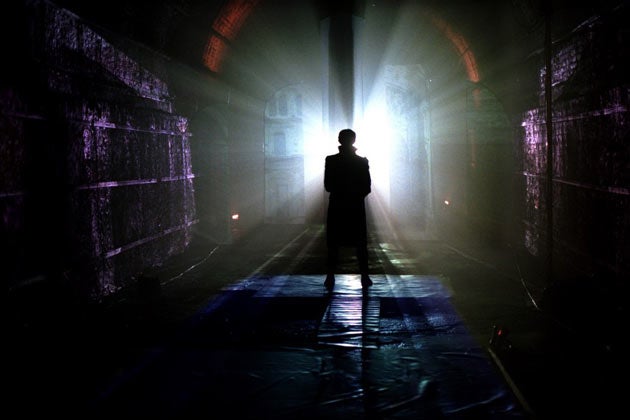Song of the City, Southwark Playhouse Vaults, London<br/>Don Quixote, Royal Opera House, London<br/>Homage to Fokine, Royal Opera House, London
Underneath the arches, a rendezvous for the realist, the artist and his muse

Any celebration of Rabindranath Tagore is bound to seem a bit superfluous. His extraordinarily prolific life, with its output of novels, poems, dramas, short stories, drawings, philosophical and political meditations, over 2,000 songs and the national anthems of not one, but two countries, India and Bangladesh, was its own celebration. Tagore, the first non-European to win the Nobel Prize for Literature, believed that in art "man reveals himself and not his objects", so anything a celebrant might want to say about him has almost certainly already been said, better.
Choreographer Ash Mukherjee hasn't entirely solved that problem in his new piece for Akademi. There are passages in Song of the City, created to mark the 150th anniversary of Tagore's birth, when the eye wants everything to stop so the ear can concentrate. Tantalising phrases about the city's "trumpet of conquest" calling men to take whatever they want are cast away by a less than Caesarean sweep of an arm, or a leg swinging loosely when it could have been sharply marking out new territories.
By using Tagore's work as inspiration rather than text, Mukherjee has sacrificed both context and gravitas. What he has gained is the freedom to create his own allegory, using contemporary dance and classical Indian Bharatanatyam, about the conflicts of realism and creativity in the daily obstacle course of urban living.
Gian Luca Loddo is the realist, Kim Amundsen the artist, and Kamala Devam the muse who tries to reconcile them – although the identities of the men take more working out than Mukherjee might wish. The pale, glacier-eyed Amundsen, in a gold-threaded regency frock coat and flouncy shirt does look like Thin White Duke-era David Bowie enjoying a flirtation with the New Romantics. But his relationship with the muse begins cruelly, disdainfully, lifting her from the floor with a foot placed beneath her chin and flicking her erect, or driving her along with his hand like a blade at the top of her skull. Loddo, dark, unshaven, all in black with an unbuttoned shirt, has a richer, more Byronic relationship with the tireless Devam.
Composer Arun Ghosh, who commits the entertaining sacrilege of layering a dub aesthetic on a selection of Tagore's Bengali songs, also appears in some of the strongest dance sequences, playing clarinet like a skinny Mod snakecharmer, coaxing hypnotised solos from the cast. The non-Indian dancing is uniformly well done, if sometimes lightweight, although Devam especially brings a serpentine intensity to every step. The Indian dance, although it sometimes exposes the dancers more, is mysteriously fitting for the subterranean arches of the Southwark Vaults. Its intricately exact percussion of stamps and claps re-animate the gloom, like ghostly gears and levers of the engines that once cut the tunnels. What started as a celebration of India's greatest writer has evolved into an engrossing urban seance.
Another great writer gets casually disembowelled in Don Quixote. Alexander Gorsky's production, staged for the Bolshoi in 1900 and now danced by the Mariinsky, uses the peripheral presence of Cervantes' errant knight as transparent excuse for a thin romantic comedy, and then uses the comedy as transparent excuse for the most shameless showboating in ballet. No matter, when the lovers are played by one of the hottest couples in dance. Anastasia Matvienko is what you might get if Penélope Cruz could do fouettes. A deep, dark serenity remains unbroken beneath all the technical exertions and faked tantrums demanded by the role. She will be one of the great Kitris when she takes even more risks. As her suitor, Denis Matvienko spins like a man who has never heard of friction. They are a gala organiser's dream.
The Mariinsky's Homage to Fokine has something for everyone, from the limpid abstractions of Chopiniana to the very credible harem orgy in Scheherazade, via The Firebird, a ridiculous panto with a great score and a superb title role. As the firebird, Ekaterina Kondaurova was a darting, quivering, flashing-eyed force of nature, and every second she wasn't on stage felt wasted, even with Boris Gruzin and the Mariinsky orchestra doing their best to reclaim Stravinsky as a Russian Romantic.
In Chopiniana, the young British dancer Alexander Parish, lured away from the Royal Ballet a couple of years ago, showed why we shouldn't have let him go. Long, clean lines and a soft jump did a lot to redeem the jerky phrasing that came between. Parish is still a work in progress, but veteran Igor Zelensky, powerful, magnetic and oozing testosterone as the Golden Slave in Scheherazade, showed just how high he should be aiming.
Next week
Clifford Bishop brushes up his Tolstoy for the Mariinsky's Anna Karenina
Dance choice
After its sell-out success at the National Theatre last year, Fela! transfers to Sadler's Wells, London, till 18 Aug. Telling the politically charged story of Nigerian musician and activist Fela Kuti through his own afrobeat music and energetic, exuberant dance, the show promises a life-affirmingly and lively evening out. Audiences can expect to join the dance party.
Subscribe to Independent Premium to bookmark this article
Want to bookmark your favourite articles and stories to read or reference later? Start your Independent Premium subscription today.

Join our commenting forum
Join thought-provoking conversations, follow other Independent readers and see their replies